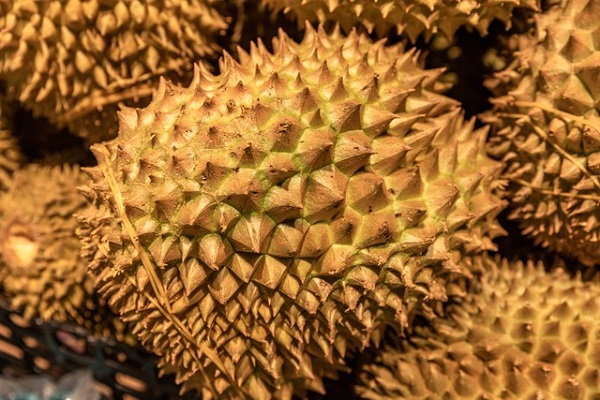
[Photo/IC]
"Wow, it looks delicious!" one taster exclaimed as Ma Yuzhong, an employee at the Hainan Youqi Agricultural Company, split open a ripe durian that had just fallen from a tree in the company's plantation in the Yucai Ecological Zone of Sanya, Hainan province.
With a fresh yet mild fragrance and glistening yellow pulp, the Sanya durian, China's first homegrown variety, looks and tastes a bit different from its Southeast Asian counterparts. Unlike other types, its rind is yellow-green, and its pulp is not slimy, but rather a bit chewy and delicate. Its pulp does not stick to its shell, its core or people's hands.
"The average amount of sugar in a Sanya durian exceeds 38 grams, making it twice as sweet as lychee," said Du Baizhong, the company's general manager and president of the Hainan Durian Association.
Durian that are unripe when picked and then ripen while being transported usually have 25 to 30 grams of sugar each.
Du noted that the biggest advantage of Sanya durian production is that they ripen naturally on the tree, unlike other commercialized varieties, and they have a high proportion of pulp.
"We let them ripen and fall to the ground naturally without using any artificial methods to accelerate the process. When durian begin to mature, they release ethylene, which allows the spiky fruit to ripen from the inside out, so its texture is not sticky and its scent is less intense," he explained.
Wen Chao, founder of the Wenji Durian brand, tasted five Sanya durian on July 25. He said two of the five exceeded his expectations.
"Given that the trees are only 3 years old, even in Southeast Asia, this fruit would be considered world-class," he said.
Feng Xuejie, director of the tropical fruit tree research institute of the Hainan Academy of Agricultural Sciences, told China Newsweek that Hainan introduced durian trees from Malaysia in 1958, but due to the lack of management, they only bore one fruit, and some began to question whether Hainan was suitable for plantation.
In 2015, however, 44 durian trees were introduced to Baoting Li and Miao autonomous county as part of afforestation efforts, and in 2019 they successfully bore fruit, which inspired the Hainan Youqi Agricultural Company to cultivate the tropical crop in Sanya, Baoting and Ledong county.
Growing the fruit in Hainan is advantageous due to the island's abundance of sunlight. But in Sanya, the largest durian plantation area of the province, its rainfall mainly occurs between July and September, which poses a challenge to farmers who need to ensure the trees are properly watered throughout the year.
To address the uneven rainfall, the company has built a reservoir and transformed its irrigation system, and has begun monitoring the growth of durian trees through sensors.
"We have adopted smart agriculture, as well as fertilizer and water automation. For example, we use a modern micro-spray system. If there is a shortage of water, the system will nourish the durian trees in a timely manner," said Lang Haibo, the company's deputy general manager.
Du said: "We also make our own organic fertilizer for the trees. We use local fish that have been fermented to make a protein, together with bean protein fertilizer."
Du's company is Hainan's largest durian producer. It has planted more than 466 hectares of durian trees in Sanya, of which about 86.7 hectares bore fruit for the first time in July and will finish yielding this month, with a total output of more than 40 metric tons expected.
The company hasn't yet put its first batch of durian on the market this year, but it has held durian tastings.
Durian is one of the top imported fruits in China.
"But next year, durian lovers will be able to purchase Sanya durian in tasting houses in cities such as Beijing, Shanghai and Guangzhou, Guangdong province," Du said.
The company is developing a quality rating system and constructing a cold storage chain to lock in the fruit's natural taste, so that people in other areas of China can enjoy the fresh taste of Sanya durian next year.
In Qionghai's World Tropical Fruit Agricultural Base, many varieties of well-known durian trees introduced from Southeast Asia are bearing fruit. Some of these durian have been sold across the country, according to the city's media center.